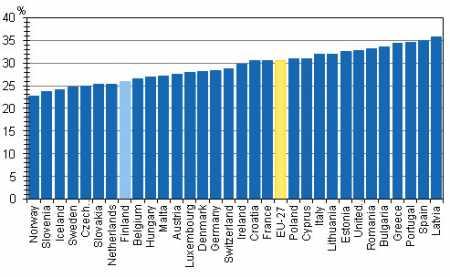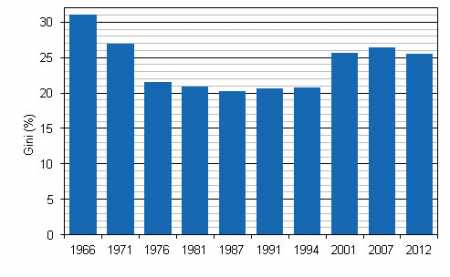|
Wed, 28 May, 2014 12:03:17 AM FTimes Report, May 28  Income inequality in the European countries 2011, Gini coefficient (%), equivalent disposable money income. Source: Statistics Finland. Income differentials in Finland are still smaller than the EU average even though they grew rapidly by international comparison in the late 1990s.
In 2011, the smallest relative income differentials in Europe were found in Norway and the largest in Latvia.
In Finland, the average income of the highest-income decile was 5.4 fold that of the lowest-income decile, while in the countries with high income differentials it was more than tenfolds.
These data are derived from the results of the EU Statistics on Income and Living Conditions, where Finland's data are based on Statistics Finland’s income distribution statistics.
The most common income inequality indicator, the Gini index, was 25.9 in Finland in 2011 when the average for EU member states was 30.6. The Gini coefficient gets the value 0 if everyone receives the same amount of income and 100 if one income earner receives all the income.

Income inequality in Finland 1966–2012, Gini index (%), equivalent disposable money income. Source: Statistics Finland. The smaller the Gini coefficient, the smaller the income differentials are. Income differentials are usually larger in eastern and southern European countries where the income level is also lower.
Measured both by income level and income differentials, Finland belongs to the group that contains mainly central and northern European countries. Income refers to the purchasing power adjusted monetary income after taxes and consists of earned income, property income, and other transfer income.
In Finland, income differentials narrowed down from the mid-1960s until the 1980s. After this, the changes were small until the income differentials grew over a few years in the late 1990s close to their current levels.
The Gini coefficient of disposable monetary income grew by around five percentage points from 1994 to 2001. In 2012, the Gini index was nearly the same as in 2001 and around one percentage point smaller than before the economic crisis in 2007.
The data are based on an internationally comparable income concept that does not include imputed income items or capital gains.
More News
|
|
Finland Times
| Friday, 19 September, 2025 |

